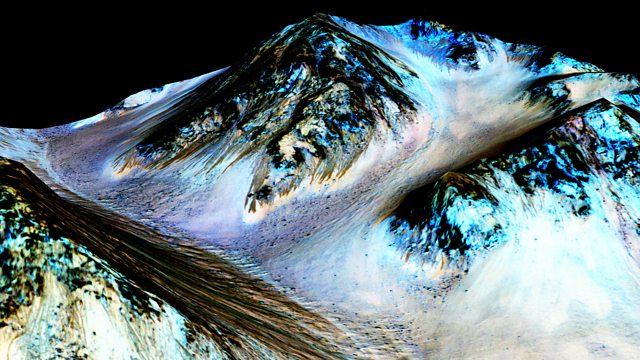Water Flows on the Surface of Mars
Water on surface of Mars; How good is the science in the new film The Martian?; What food would you grow on Mars?; Comet 67P made from two objects; ArcticMix; Seedbank in Syria
Dark streaks on crater slopes on Mars have been identified as salt deposits. The presence of salt could be the strongest evidence of liquid water on the surface of the Red Planet. While Martian surface temperatures range between zero and -100C, the high salt content of the water could act as an anti-freeze, keeping the water liquid.
The Martian
The movie based on the science fiction book of the same name by Andy Weir details the plight of astronaut Mark Watney, who during a manned mission to Mars, is presumed dead after a fierce storm. He is left behind by his crew. But Watney has survived and finds himself stranded and alone on the hostile planet. With only meager supplies, he must draw upon his ingenuity, wit and spirit to subsist and find a way to signal to Earth that he is alive.
Comet 67P Made from Two Objects
The two lobes that give comet Churyumov–Gerasimenko (67P) its characteristic ‘rubber duck’ shape were once distinct objects that merged after formation. Using high-resolution data from the OSIRIS imaging system on the Rosetta spacecraft, scientists have shown differences between the cometary lobes, made up of stratified, ‘onion-like’ layers. It is thought that the cometesimals were formed by similar accretion processes before they merged, in the early Solar System.
ArcticMix
Oceanographers in the ‘ArcticMix’ team have gathered fresh evidence that wind-driven turbulence in the Arctic Ocean is stirring up heat from the depths. The more ice that melts, the more exposed the ocean is to the wind.
Seedbank in Syria
We are never more reminded that we live in a truly global village than when we look at a plate of food. There could be potatoes and tomatoes that evolved in South America, bread made with wheat which started in the Middle East, cassava, now an African staple, originated in Brazil. Crop diversity is of increasing importance and if we want to have this variety of food in the future, with a growing population and a changing climate, we need to look after the hundreds and thousands of genetic varieties of the food plants we grow and eat. And this is where seedbanks come in. Seedbanks are one of the planet’s insurance policies to ensure we can access crop varieties to help improve our crops. But seedbanks are not static ‘museums’ of crop seeds and plant material. Plant breeders, farmers and scientists can, and do, request access to seeds in national collections all the time. But this is the first time an international collection has requested a seed withdrawal from the ultimate seed back up bank – the Svalbard Global Seed Vault. Due to the civil war in the region, ICARDA - International Center for Agricultural Research in Dry Areas that was housed in Aleppo in Syria is moving and it needs its seed deposit back.
(Photo: Dark, narrow streaks on Martian slopes such as these at Hale Crater are inferred to be formed by seasonal flow of water on contemporary Mars © NASA/JPL-Caltech/University of Arizona)
Last on
Broadcasts
- Thu 1 Oct 2015 18:32GMTÂ鶹ԼÅÄ World Service except East and Southern Africa & West and Central Africa
- Thu 1 Oct 2015 19:32GMTÂ鶹ԼÅÄ World Service East and Southern Africa & West and Central Africa only
- Thu 1 Oct 2015 23:32GMTÂ鶹ԼÅÄ World Service
- Fri 2 Oct 2015 02:32GMTÂ鶹ԼÅÄ World Service Europe and the Middle East & Australasia only
- Fri 2 Oct 2015 04:32GMTÂ鶹ԼÅÄ World Service Online, South Asia, UK DAB/Freeview & Americas and the Caribbean only
- Fri 2 Oct 2015 05:32GMTÂ鶹ԼÅÄ World Service East Asia
- Fri 2 Oct 2015 06:32GMTÂ鶹ԼÅÄ World Service Europe and the Middle East
- Fri 2 Oct 2015 12:32GMTÂ鶹ԼÅÄ World Service except Americas and the Caribbean & Australasia
- Fri 2 Oct 2015 13:32GMTÂ鶹ԼÅÄ World Service Australasia
Podcast
-
![]()
Science In Action
The Â鶹ԼÅÄ brings you all the week's science news.


